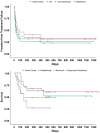Management of vancomycin-resistant Enterococci and daptomycin-resistant Enterococci infections in liver transplant recipients in a single academic center
- PMID: 39368075
- PMCID: PMC11666863
- DOI: 10.1111/tid.14387
Management of vancomycin-resistant Enterococci and daptomycin-resistant Enterococci infections in liver transplant recipients in a single academic center
Abstract
Introduction: Vancomycin-resistant Enterococci (VRE) infections cause significant morbidity and mortality in liver transplant (LT) recipients. Management is challenging, especially in the setting of daptomycin resistance (DR).
Methods: Single-center retrospective review of patients who underwent LT between January 1, 2020, and December 31, 2022, and developed VRE infections. Descriptive statistics were used and Kaplan-Meier curves estimated freedom from treatment failure and survival.
Results: Forty-two patients (median age 58; 64% female; 67% white) were included. Alcohol-related cirrhosis (48%) and metabolic dysfunction-associated steatohepatitis (31%) were the most common indications for LT, and most were from deceased donors (86%). VRE infection occurred at a median of 21 days after LT, and 16% had known prior VRE colonization. Common infection sites were blood (45%, n = 19), intraabdominal (36%, n = 15), and urine (36%, n = 15). Most were initially treated with daptomycin alone (64%) or in combination with other agents (21%); 7% received linezolid alone. Twelve (29%) developed breakthrough infections during treatment and 11 (26%) had recurrent infections after discontinuation of treatment. All-cause mortality was 36% (n = 15) at a median of 90 days after VRE infection diagnosis and was nearly twice as high in patients with DR (63%).
Conclusion: VRE infection in LT recipients relapsed or recurred in over 25%. Mortality was high, especially in cases with DR. More data is needed to establish an optimal treatment approach, particularly for relapse and DR.
Keywords: eravacycline; liver transplant; vancomycin‐resistant Enterococci.
© 2024 The Author(s). Transplant Infectious Disease published by Wiley Periodicals LLC.
Conflict of interest statement
Megan Morales was a paid speaker for Karius, Inc. and a consultant for Cidara Therapeutics. Nicole Vissichelli was a paid speaker for Karius, Inc. Idris Yakubu was a paid speaker for Veloxis Pharmaceuticals and Takeda Pharmaceuticals. The authors declare no conflict of interest.
Figures

References
-
- Baddour LM, Wilson WR, Bayer AS, et al. Infective endocarditis in adults: diagnosis, antimicrobial therapy, and management of complications: a scientific statement for healthcare professionals from the American Heart Association. Circulation. 2015;132(15):1435‐1486. doi:10.1161/CIR.0000000000000296 - DOI - PubMed
MeSH terms
Substances
LinkOut - more resources
Full Text Sources
Medical

